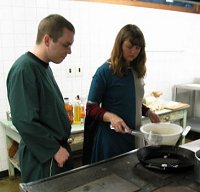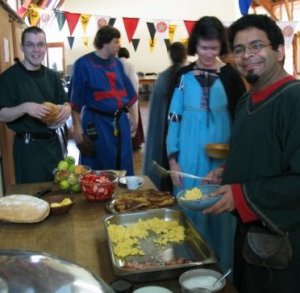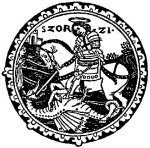|
Here Be Dragons Genadendal, 1-2 November 2003 Head Cook: Lady Jehanne de Huguenin This was our first ever event that ran for more than one day, and entailed travelling out of Cape Town, and away from the familiar confines of my kitchen, known event sites, handy shops and the like. It was also the first time I had cooked for an entire weekend, rather than simply a feast with possibly a lunch snack table. Challenging all round, and, in the event, enormous fun. I envy those SCA types who regularly cook for longer events – the untold luxury of being able to recover after the feast by becoming happily tipsy, bed within staggering range, and not having to pack the damned car, cannot be overstated. On the other hand, I forgot to pack the cream when transferring food from my fridge into the coolers for the trip. We had to buy out all the cream in the little shop in the town when I realised what had happened. I also had to make about three crème caramels in a row when I got back. (Darn). Genadendal is a tiny little town in the mountains about one and half hour’s travel from Cape Town, the site of the oldest mission in South Africa (only 18th century, but hey). The lovely old buildings included a large, attractive hall with a big kitchen, useful quantities of cooking utensils (including big pots), and a terrifying bank of enormous commercial stoves, which turned out to have a bizarre and dodgy relationship between the oven and the plate on top. Using the top plates, it transpired, caused superheating in the oven below (scorched fruit tarts). Not using the top plates caused a ve –e –e-ry slo –o –ow oven beneath (late second course). Next time I shall bring a couple of electric hobs. Things the kitchen did not include included an egg whisk. We whipped the cream by passing it around the Shire in a plastic bottle containing two teaspoons, and demanding that everyone shake it. The upshot was something a bit like a conga line. In honour of the Bavarian founders of the Genadendal Moravian mission, I chose to cook from German sources, including one 14th-century source and two 16th-century. This is a lovely cuisine, one of my favourites, with a good selection of recipes. I had to provide lunches on Saturday and Sunday, breakfast on Sunday, and the feast on Saturday night. Lady Ginevra kindly volunteered to do the initial lunch, which took some of the pressure off, but the rest I cooked myself. There were only 20 of us, so it wasn’t particularly demanding. Breakfast in medieval times was very different to our current assumptions, so I fear I departed from strict medieval accuracy in order to give early-morning people more familiar food. I’m not sure how the Shire would take to bread, fish and ale first thing in the morning… There is a scrambled-egg-like dish in the English 14th century corpus, so it’s not too much of a stretch. Tea and coffee are not in any way period at all, but I’m not dealing with the Shire on no caffeine. More importantly, the Shire doesn’t want to deal with me on no caffeine… Please note that I’m terrible at measuring when I cook, so quantities given below are somewhat impressionistic. Bibliography Das Buch von Guter Spise (14th century), tr. Alia Atlas.
Das Kochbuch der Sabina Welserin, tr. Valoise Armstrong
Ein New Kochbuch (1581), by Marx Rumpolt, tr. M. Grasse
Maister Hannsen des von Wirtenberg Koch, 1460, tr. Rita Drexl As usual, grateful thanks to the SCA cooks who translate these works and make them available on the web. This kind of feast would not be possible without them.
Saturday Lunch Lunch cook: Lady Ginevra del’Acqua |
| A fladen of meat (pork and cheese tart) - Guter Spise
A spinach tart - Marx Rumpolt Venison sausage Bread, cheese, fruit |
|
A fladen of meat (Guter Spise 92)
A turten of spinach (Marx Rumpolt, Turten 39)
Venison sausage
Saturday Feast First course: assorted small meats |
Knodel (beef meatballs) - Marx Rumpolt
|
 Mogr laying out starter platters in the kitchen. | The first course was platters with a whole assortment of finger-foods, nicely arranged with red and green lettuce. I probably overestimated quantities (as usual), since the Shire polished off the platters in short order, but had not quite enough room left for the main course. |
|
Rindfleisch Knödel ( Rumpolt, Beef 67)
This is a fairly standard meatball; I soaked the bread in beef stock for added flavour, and used whole raisins. The recipe specifies serving in a pepper sauce, but I omitted this for ease of finger eating, and upped the pepper quantities in the actual meatball to compensate the flavour. These were good – the additional pepper gave them a bite. I interpreted the "salat" as spinach, which also added flavour. The saffron was not really detectable against the other strong flavours. 500g beef mince (not too lean, the fat is necessary for tenderness)
Mix seasonings and spinach with ground meat. Grind the bread to break it up, and add to mince mixture, with raisins. Bind with egg. Form into small meatballs and fry in shallow fat at medium temperature (if the fat’s too hot you’ll end up crisping the outside before the middle is cooked. For the same reason, I prefer to make little bite-sized meatballs). Mörserhühner mach wie folgt (Meister Hannsen)
These are the infamous "chicken McNuggets" of medieval cuisine. At the time, I interpreted this as chicken pieces fried in a spiced batter. On re-reading the recipe, however, I’m inclining to the belief that the recipe actually requires you to mash the dough in a mortar with the chicken, so that the result is rather a sort of fritter containing ground chicken rather than a batter-encased chicken piece. The recipe below, however, is the one I used at the feast. Please note the above disclaimer that I don’t actually think it’s a valid interpretation! On the other hand, they were very good, and went down well with the Shire. 6 skinned, deboned chicken breasts
|
 Me and Llewellyn frying Chicken McNuggets. | Poach the chicken breasts in the chicken stock (make sure they’re cooked through). Cut breasts into bite-sized pieces.
Add seasonings to flour; break eggs into flour and add milk to make a thinnish batter, stirring lots. Dump chicken pieces into the batter and mix to coat. Lift out with a perforated spoon and fry in shallow oil to brown evenly on all sides. Try to serve these hot, they get a bit leathery otherwise. |
|
To make the mustard for dried cod (Guter Spise 34) Okay, I cheated with this. Take hot commercial mustard. Take pureéd stewed pears. Mix commercial mustard into stewed pears until a pleasing balance of flavours results. Actually, I really liked this – its hot/sweet taste is distinctive and very good. Ein gut salse (Guter Spise 49) Take wine and honey. Set that on the fire and let it boil. And add thereto pounded ginger more than pepper. Pound garlic, but not all too much, and make it strong and give it impetus with eggwhites. Let it boil until it begins to become brown. One should eat this in cold weather and is called Swallenberg sauce. Be vewwy, vewwy careful with this recipe – it is fatally, horribly easy to curdle the eggwhite and give yourself icky brown curdy-looking yuk instead of a smooth sauce. 250 ml white wine
Boil wine and honey together and add spices and garlic. Cook gently for a fair amount of time, until the liquid begins to reduce. REMOVE FROM THE HEAT AND ALLOW TO COOL A BIT! Beat eggwhites in a bowl, and add a few spoons of the wine/honey mix. Beat together. Gradually, and off the heat, add the eggwhite mix to the pan of honey/wine mix. Stir madly with a wooden spoon. Cautiously, and with extreme respect, introduce the pan to a very gentle plate on the oven. Stir madly and continuously. Allow to thicken. Take far away from heat the instant you think it’s starting to look ready. Hard boiled eggs (Rumpolt, Salads 23)
These were simple, but surprisingly good. The effect is a sort of nouveau cuisine, with the finely-chopped parsley sprinkled over the eggs (hard-boiled and sliced in half). Sprinkling the vinegar evenly and sparingly is a bit of a trick, especially if the special nozzle on the vinegar bottle is, like mine, buggered, giving splooshes rather than drops. I used apple cider vinegar, just because. Cucumbers (Rumpolt, Salads 20)
A basic cucumber salad – sliced cucumber with olive oil, salt and pepper. Same goes for the lettuce and radish, below. The overall taste and visual combinations were good. Red beets (Rumpolt, Salads 29)
Cheated again. Used commercial pickled red beets. Green Salad (Rumpolt, Salads 20)
Radishes (Rumpolt, Salads 20)
Second Course |
A Good Food (chicken with pears) - Guter Spise
|
|
Ein gut spise (Guter Spise 30)
This is one of my favourite German recipes; the pear sweetness works really well with the chicken. 8 chicken breasts, with skin and bone
Roast chicken pieces, covered, in a medium oven (180 degrees) for about half an hour. Core pears and cut into quarters or eighths (I leave the skin on for added flavour). Remove cover from roasting pan and add pear pieces to the pan, making sure they pick up the meat juices. Continue roasting uncovered until the chicken is brown and the pear pieces soft.
Garlic roasted leg of Mutton (Rumpolt, Mutton 35)
This is a straightforward roasting recipe. I usually lard it with garlic (cut slits in the skin and insert slivers of garlic, to taste, i.e. I use a lot) before roasting, rather than half-way through. Deglaze the roasting pan with red wine vinegar and stock, with additional garlic and pepper. Slice the cooked roast finely and serve on platters covered with the sauce. Rice in almond milk (Rumpolt, Vegetables 173)
Standard medieval recipe: I make almond milk with ground almonds and add it in the last part of cooking. Garnish with slivered almonds. Onion Salad (Rumpolt, Salads 10)
This was a lovely recipe. Fry onion slices (I cut them in rings) slowly in a little olive oil, so they go translucent and sweet rather than caramelising. Season with a teaspoon or so of sugar, and add a handful of raisins half-way through cooking. The taste is surprisingly sweet. Carrots in cream (Rumpolt, Vegetables 186)
500g carrots
Peel and slice carrots (fairly small), and boil in salted water until almost done. Drain. Melt butter in a pan and briefly stir-fry the carrots to coat in butter. Just before serving, add cream and toss to coat; heat briefly. Salt to taste.
Young gourds (Rumpolt, Salads 35)
This is a salad, served cold, which gets it neatly out of the way early. I use baby marrows, sliced in half lengthways and cooked in chicken broth until just tender. Allow to cool to room temperature, and season with salt, vinegar and olive oil an hour or so before serving. (Balsamic vinegar is good on these).
Third Course |
Peach Tart - Marx Rumpolt
|
|
Peach Turten (Rumpolt, Turten 9)
To make a strawberry tart (Sabina Welserin 89) These were not successful, owing to the aforementioned problem with the oven. They were scorched. Fortunately, the Shire were so full by that stage that I’m not sure they noticed the deficiencies of dessert. I used a standard shortcrust pastry recipe for both tarts, baked blind. about 12 whole fresh peaches
For each pastry case: 200g flour, 100g margarine, 1 egg yolk, 1 tsp salt. For pastry: mix salt and flour, cut fat into the flour, rub in with the fingers. Add egg yolk and a little iced water. Mix, adding water until pastry starts to bind together. Form into a ball and chill in the fridge for 20 mins or so.
Sunday Breakfast |
Tea/coffee
|
|
To make filled Semmel (Sabina Welserin 56)
|
 The Shire at breakfast, looking bizarrely cheerful. |
This was a hit with the Shire. It’s basically sweet French Toast. 6-8 slices of bread, 4 egg yolks, a little milk, cinnamon, nutmeg, honey. Slice bread quite thickly, and spread each slice with honey. Make a batter with the egg yolks, a little milk and the spices. (I added a tsp or so of sugar). Dip each slice briefly in the batter, coating both sides, and fry in shallow fat until golden brown. NB make sure the fat is hot enough, otherwise the slices absorb it. |
|
Sunday lunch |
Heathen Pies (meat, bacon and apple) - Guter Spise
|
|
Heidenische kuchen (Guter Spise 5)
500g pork meat, cooked and chopped finely (or you can cheat and used uncooked ground pork, or disassembled pork sausages)
Chop bacon finely; peel and core apples, chop finely. Mix chopped cooked pork (I like to poach it) with apples, bacon, eggs and spices, and pack into a tart case (no need to pre-bake). Cook at 180 degrees for 30-45 mins, until the top is brown and the meat cooked through. Einen krapfen (Guter Spise 61)
A basic apple pie, although the high nut content is particularly good. 1 recipe shortcrust pastry (see above)
Peel and chop the apples, place in a roasting pan, drizzle with about half the honey, and roast in the oven for 20-30 mins at about 180 degrees. Remove and chop to about the same size as the walnut halves. Mix apples and walnuts with spcies, and pack into an uncooked pastry case. Drizzle with remaining honey and bake at 200 degrees for about 30 mins, or until pastry is browned and honey caramelised. |



